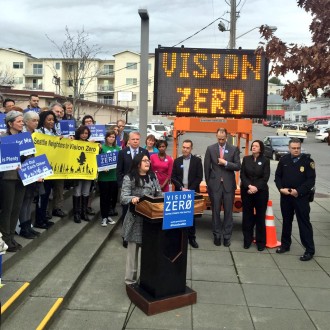
Sandhya Khadka dreamed big. She believed in equality, especially equality for women, and she was dedicated to do something about it.
“There are people you remember for long after they are gone. Sandhya was one of those,” said family friend Writu Kakshapati. Kakshapati was speaking to a crowd gathered last week to hear about the city’s plans to end traffic deaths and serious injuries by 2030.
In fact, she was speaking on what would have been Sandhya’s 18th birthday. But instead, Sandhya was killed in April while crossing 5th Ave NE to catch the 41 bus so she could get to class at North Seattle Community College.
“We mush make an effort that we don’t lose another life like that, not on our streets.”
Sandhya was one of 15 people killed in traffic last year on Seattle streets. 3,449 collisions resulted in injuries. That’s part of a downward trend in traffic violence that makes Seattle one of the safest big cities in the country.
But we lost Sandhya and all of the great things she was going to do with her life. That loss is immense to her family (she was an only child and an only grandchild), and it did not need to happen. Hundreds of people were seriously injured, many left with injuries that will forever change their lives.
Vision Zero says that serious traffic collisions are preventable, and no death or serious injury is acceptable. After all, it is hard to learn about Sandhya’s life and still feel good about 15 traffic deaths in just one year.
“I’ve met parents, spouses and children whose lives have been upended by traffic collisions,” Mayor Ed Murray told the crowd gathered in front of Lake City Library. He also told a personal story about when someone driving struck him when he was a child. He was in the hospital for a long time as he recovered from the collision.
“To this day, I suffer the fallout,” he said. “I remember the anguish my parents went through week after week at the hospital … That’s what this is all about.”
“If there’s any city in our country that can achieve [Vision Zero], I think it’s Seattle,” said SDOT Director Scott Kubly. He believes Seattle can reach zero deaths and serious injuries in traffic by 2030. It’s an extremely ambitious goal, and no large city has reached it since the dawn of the automobile.
But many cities have radically reduced the human toll of traffic violence in recent decades, For the first time in several generations, Vision Zero may actually be within reach. Think of traffic violence as a terrible disease, and we’re starting to see the path to eradication.
Thursday’s Vision Zero press announcement is actually the second time in recent years that city leaders gathered press to call for an end to traffic deaths and serious injuries. In fact, the Vision Zero is not a comprehensive road safety document like 2012’s Road Safety Action Plan, which set the same goal. Vision Zero Seattle is more like a concrete plan for what the city is going to do right now in 2015 to reduce traffic violence, including some new strategies. It’s also a rebranding of the effort to help tie into efforts from Sweden to New York City and, as of this week, Portland.
So can Seattle actually get to Vision Zero? It’s not gonna be easy, but Seattle may be the major US city with the best chance to get there. Let’s look at the data.
About 150 people are seriously injured in traffic every year. About 20 people die. This is down about 30 percent since a decade ago despite a significant increase in population. Every October from now on, the city will revisit this data to evaluate Vision Zero progress.
Data shows that traffic collision and injury trends in Seattle are already trending in the right direction. In fact, people in cars have been the biggest beneficiaries of road safety improvements to date (and yet some people called these changes a “war on cars”). Improved vehicle safety standards likely also plays a role in this decrease as older, more dangerous cars head to the scrap yard.
But the safety increases have not been equal for everyone. While people biking, walking or riding motorcycles are only involved in 5 percent of collisions, they make up 50 percent of fatalities.
So the city needs to continue making streets safer for everyone, but there needs to be special focus on walking, biking and motorcycles if we are going to eliminate fatalities.
Road safety design changes have proven to be our most effective tool for quickly and permanently reducing dangerous collisions. And these changes do not need to cost a lot of money, as highlighted by the 2013 changes to NE 75th Street:
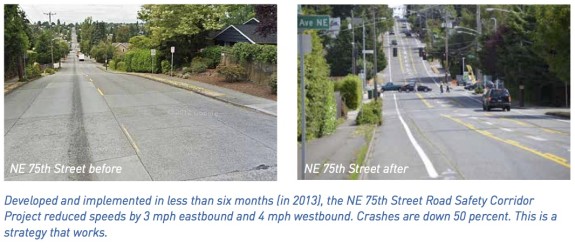 Obviously, 50 percent reduction is not 100 percent, but it’s a huge start. It’s also even better than safety results on Nickerson Street — which saw a promising 23 percent reduction in collisions after road design changes a few years ago — and the 10 percent decrease in collisions on NE 125th. This suggests two important things:
Obviously, 50 percent reduction is not 100 percent, but it’s a huge start. It’s also even better than safety results on Nickerson Street — which saw a promising 23 percent reduction in collisions after road design changes a few years ago — and the 10 percent decrease in collisions on NE 125th. This suggests two important things:
- Many people have been saved from death and seriously injury thanks to these changes.
- The city keeps getting better at designing road safety projects.
The city’s more ambitious complete streets designs that include wider and better protected bike lanes and walking spaces could continue to improve this safety record.
Downtown
Downtown streets are an artifact from a traffic engineering age that has proven to be extremely dangerous. They are wide, packed with travel lanes and controlled by a traffic signal system far more focused on funneling cars onto freeways than protecting the lives of people walking and biking.
During rush hour, downtown streets are filled with people in cars queuing to get onto the freeways. Outside of rush hour, speeds can get surprisingly high on streets packed with people. It’s a recipe for disaster, which is why it should come as no surprise that downtown is by far the most dangerous place to walk. From the Vision Zero plan:
Most pedestrian collisions occur downtown. In fact, more than 600 people have been hit while walking downtown in the last three years. While we’ve seen positive safety gains outside of the city center, we’ve seen an increase in the severity of collisions in the central business district – specifically collisions involving speeding.
Making downtown safer is going to take a lot of work. In 2015, the city plans to begin lowering speed limits from 30 mph to 25 and begin phasing out right turns on red, which endangers people walking in crosswalks (people driving are often watching for gaps in traffic and fail to see the person walking right in front of them). Details:
- Reduce speed limits to 25 mph throughout downtown, starting with Pike, Pine and James streets
- Data-driven pedestrian safety enhancements may include leading or lagging pedestrian intervals, protected turn phases, elimination of dual turn lanes, signal improvements, and no turns on red. 2015 locations include:
• 5th Ave at Union, University, Spring, and Seneca Streets
• 6th Ave at Pike, Spring, Cherry, James, and University Streets
• 7th Ave and Olive Way
Reduce speeding on busy neighborhood streets
90 percent of all traffic deaths and serious injuries happen on arterial streets, so the majority of the focus needs to be there. But when calming traffic on busy streets, it’s also important to make sure residential streets remain low-speed and low-traffic. In 2015, the city plans to reduce speed limits on busy streets with a history of bad collisions. Here’s a map:
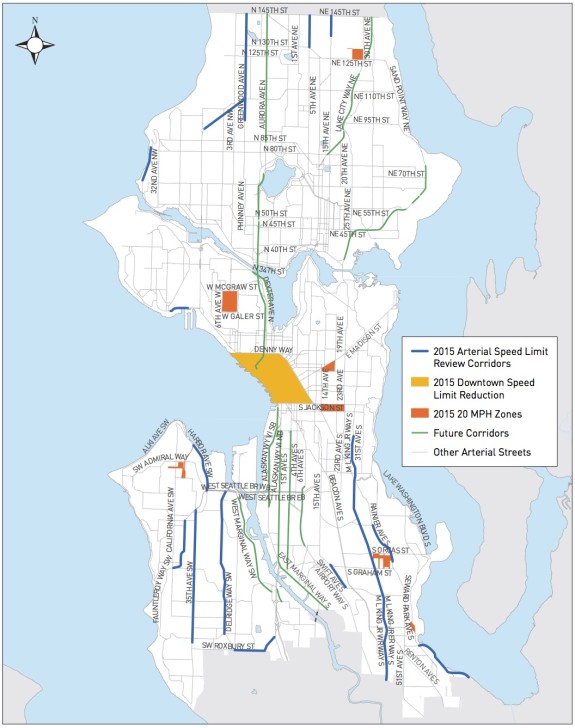 The city will also create a handful of new “20 mph zones.” These 10-15 zones on tap for 2015 are mostly pockets of residential streets near parks and schools that have a history of collisions. In addition to changing speed limits, the city will “install signage and pavement markings to clearly delineate the 20 MPH Zone and ensure intersections are cleared of obstructions to improve visibility of pedestrians in crosswalks.”
The city will also create a handful of new “20 mph zones.” These 10-15 zones on tap for 2015 are mostly pockets of residential streets near parks and schools that have a history of collisions. In addition to changing speed limits, the city will “install signage and pavement markings to clearly delineate the 20 MPH Zone and ensure intersections are cleared of obstructions to improve visibility of pedestrians in crosswalks.”
To date, only neighborhood greenways have received the lower 20 mph speed limit, so this is an interesting new strategy to lowering residential street speeds.
Eventually, it would be great to see the city reduce the default speed limit for all arterial streets to 30 or lower and the default speed limit for all residential streets to 20.
In addition to lowering speeds on busy neighborhood streets, the city will also focus on road design in problem areas:
Bring a higher level of safety to Seattle’s Urban Centers, where high volumes of vehicular traffic, transit, pedestrians, and bicyclists merge. Data-driven improvements may include modified signal phasing, traffic calming, protected turn phases and leading or lagging pedestrian intervals at the following locations:
- Lake City at NE 125th Street and Lake City Way NE
- White Center/Westwood at SW Roxbury Street and Delridge Way/16th Ave SW
- Columbia City and Hillman City on Rainier Ave S
This is all in addition to the city’s Road Safety Corridor and complete streets projects, some of which we have written about previously.
Road Safety Corridors
Reduce collisions through low cost engineering, enforcement and education efforts on targeted corridors including:
- Rainier Ave S
- Lake City Way
- SW Roxbury Street
- 35th Ave SW
- Banner Way
Complete Corridors
Plan and develop long-term multimodal improvements on corridors such as:
- Delridge Way SW
- East Marginal Way
- Yesler Way
- Greenwood Ave N
- 3rd Ave
- Beacon Ave S
Capital Projects
Transform Seattle streets through major projects designed to ensure safe travel for pedestrians, bicyclists, and drivers:
- 23rd Ave
- Mercer West
- Waterfront
- Broadway
Enforcement
Seattle Police will begin using the SeaStat crime data system to identify and target traffic law enforcement as well. The department reviews this data weekly to adjust their strategies and focus areas. The department will also focus on dangerous traffic violations like failure to yield at a crosswalk and blocking crosswalks at stop lights.
The city will also expand the wildly successful and effective school zone speed camera system to six new school zones in 2015.
The Vision Zero plan also calls for education programs and community outreach needed to teach people safer traffic behavior.
So can all this really achieve this ambitious goal? Well, there’s only one way to find out: We need to try our hardest and invest in safety upgrades at a rate we have never tried before.

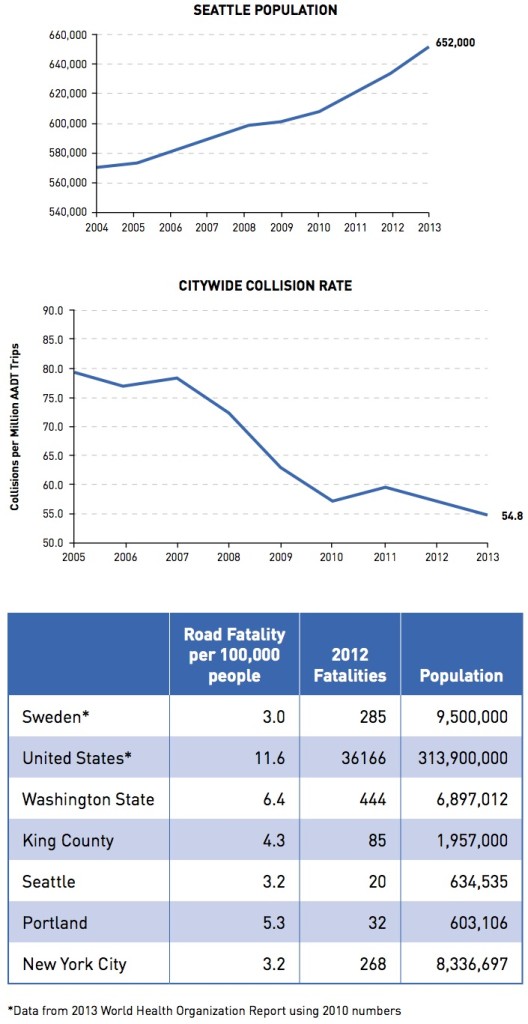
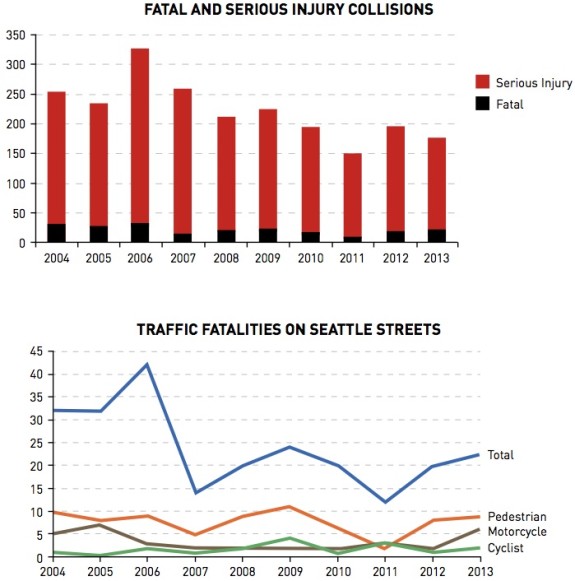







Comments
22 responses to “Can Seattle end traffic violence by 2030?”
Tom, is there a contact number or email for this project? I’d like to get my street included in the 2015 plan. I’m on QA and I see that the central section is targeted for changes this year. My street is the only one that connects with that area and Taylor Ave and, although it is a residential street, people use it as an arterial and some travel awfully fast.
Hmm, good question! The plan document does not have a specific contact for Vision Zero. I would try [email protected].
This is one of the best campaigns to show the effect of speed I’ve seen in a long time.
https://www.youtube.com/watch
Do you have a better URL? Looks like this one got cut off.
Sorry!
https://www.youtube.com/watch?v=ipnJbSnmc24
Because it so clearly shows how 5mph more/less makes all the difference.
Also this one:
https://www.youtube.com/watch?v=ViovFWFbhxs
Because it just rips your heart.
Is anybody talking about reconfiguring downtown streets to carry two-way rather than one-way traffic? I think this is one of the things that gives them the highway feel (I’m thinking of 4th Ave in particular). I wonder if two-way traffic would help calm them?
That might depend on the details — there are a million things wrong with 4th Ave (the intersection with Prefontaine, the way the left edge changes repeatedly after the bike lane ends), but I’m not sure I’d trade 5th Ave (a one-way highway lacking the particular flaws of 4th) for another 1st Ave — 1st Ave in Pioneer Square is alright (especially off-peak) but north of there it deteriorates fast; by the time you see SAM you’re deep in the No Fun Zone.
Tom, Thanks for writing this post! I appreciate the work your doing.
Since enforcement of traffic laws is pretty far down SPD’s list of priorities, lets see traffic cameras at every intersection giving automated tickets to red light runners and automated tickets to speeders starting at 1 mph over the maximum speed. Little freebies like right/left on red and that ridiculous +7-12 mph padding given to speeders are out the window, people have long since proven that they shouldn’t be given any leeway.
I say let’s give people leeway, but let’s also set the maximum speed of any city-owned street at 20mph. That way the leeway tops out at 25mph, which is still survivable in a collision. Doesn’t help with the state-owned roads but it’s a start.
20mph still gets you from the NE end of Seattle to the SW in less than an hour, assuming you stick to city streets.
I found the no right on red bit counter intuitive. I’ve always preferred right on red as a pedestrian. A right turner approaching a green is in fast traffic and just sees clear ahead. They often only slow enough to take the turn and see the peds at the last moment. At least for right on red, there is only so fast you can take it. Furthermore, right on red gives you a few seconds to start crossing without right turners impatiently edging into you because any that where at the line already turned when the light was still red. As far as the right on red car not seeing the ped, it’s always clear when someone is edging out to turn. I’ve always made sure turners see me before stepping out. Maybe I’m just bitter about my experiences on Brooklyn’s beloved parkways. The right on greens from the travel lanes to the one way cross streets are fast and turners gas through the planter part and the service lane part. The emount of times I’ve either been stuck behind a stream of rubber squealing turners or worse had to dash madly to avoid being hit makes me hate rights on green. I’ve never been inconvenienced by a right on red turner. But if the data says more peds are hit by right on red, I guess it’s right.
What’s done in France and other European countries is to move the crosswalk back from the corner. I’ll try to describe.
The stop line is moved back about 30′ from the intersection. Immediately past the stop line is the crosswalk. Then is a space where a single vehicle can wait to make a right on red.
How this works: first, if the light is red, vechicles must stop at the stop line. If there are no peds in the perpendicular crosswalk, he can proceed into the area past the crosswalk. Once in that space, he doesn’t have to look for peds any more while preparing to turn because the other crosswalk is empty – due to cross traffic and a red light for peds.
The trade offs: first, it causes peds to go a bit out of their way. Second, some vehicles are too long to fit in 20-25′ and would block the crosswalk while turning (of course, we already have that problem).
To mitigate the trade offs, only the worst intersections would have to be done this way. Of course, those with stop signs would stay as they are as well as those that are unmarked.
It’s interesting to compare the comments here to the tone of those from our more conservative neighbors down in West Seattle. People who ride bikes in Seattle like the idea of calming an increasingly belligerent traffic monster and curbing needless death and injury. In West Seattle it seems that the predominant opinion is that Big Nanny Gubmint is coming to Take Away More Rights.
http://westseattleblog.com/2015/02/vision-zero-to-reduce-speed-limits-on-5-west-seattle-arterials-maybe-another-school-zone-speed-camera-too/#comments
How about more support for the Seattle Police Department, Traffic Enforcement Unit. The support should be written and verbal statements given by the Mayor, the Chief of Police and the Head of SDOT that the men and women of the Traffic Enforcement Unit are working in concert with SDOT for the success of this Vision Zero Plan.
[…] in November. His death helped to prompt the city to include walking safety projects downtown as part of its Vision Zero plan. 5th and Seneca is on the list for improvements later this […]
[…] the city is going to reach Vision Zero, we need to continue the excellent work improving driving safety. Too often, debates over city road […]
[…] It’s not news that downtown streets are the scene of a huge number of serious traffic injuries and deaths. But this map at a recent open house still caught me completely off-guard. At first, I thought it was a map of the past ten years. How awful, so many lives ended or dramatically altered. […]
[…] your heart fill with hope for the health of your neighbors and loved ones as the city unveiled a plan to end traffic deaths and serious injuries by […]
[…] we throw down and make the most comprehensive attempt in the whole country at ending traffic deaths and serious […]
[…] Twenty people died in Seattle traffic last year, up from 2014’s total of 17 and above the trend the city needs to achieve zero traffic deaths by 2030, one of the city’s Vision Zero goals. […]
[…] plans to cut one in three projects from the five-year work plan. If the city hasn’t abandoned its Vision Zero goal — which calls for a specific focus on biking and walking safety — then it has at least made it […]
[…] collisions have shown us in the past week, we are desperately behind. Seattle can’t reach its goal of Vision Zero by 2030 by taking years off and saying we’ll fix it […]